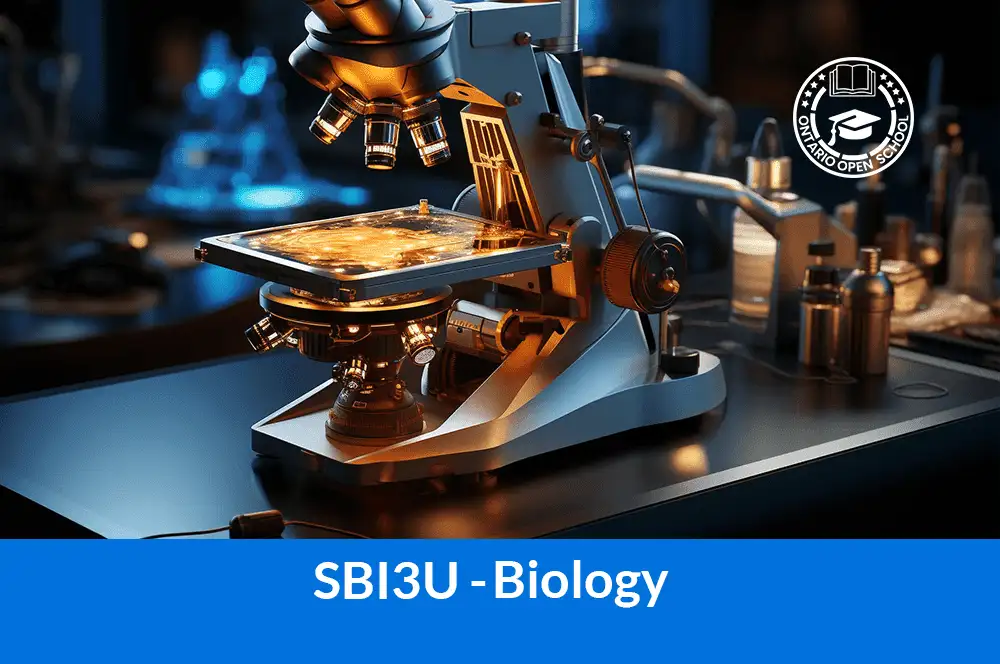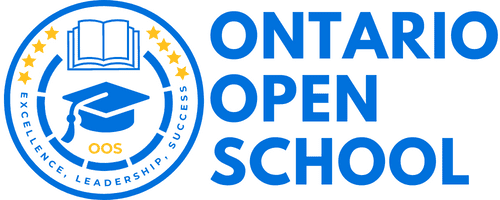- info@ontarioopenschool.com
- 647-494-4499
-
Unit 100 - 29 Gervais Drive, North York, ON.
M3C 1Y9
Copyright 2024 Ontario Open School Inc. All Rights Reserved.
This course furthers students’ understanding of the processes that occur in biological systems. Students will study theory and conduct investigations in the areas of biodiversity; evolution; genetic processes; the structure and function of animals; and the anatomy, growth, and function of plants. The course focuses on the theoretical aspects of the topics under study, and helps students refine skills related to scientific investigation.
Unit Order | Unit Name | Suggested Time |
|---|---|---|
| Unit 1 | Diversity of Living Things In this unit, students will demonstrate an understanding that all living things can be classified through the principles of taxonomy and phylogeny. They will use sampling and classification techniques to investigate the principles of scientific classification. Students will analyse the effects of human activity on the diversity of living organisms in ecosystems. | 20 hours |
| Unit 2 | Evolution In this unit, students will demonstrate an understanding of the theory of evolution and the evidence that supports it. They will examine the mechanisms by which it occurs, including thorough consideration of natural selection and punctuated equilibrium, and evaluate the logic that has drawn scientists to their conclusions. Students will also analyse the economic and environmental implications of artificial selection technology, and evaluate the impact of environmental changes on natural selection and species at risk. | 18 hours |
| Unit 3 | Genetic Processes In this unit, students will evaluate recent advances in our knowledge of genetic processes and demonstrate an understanding that genetic and genomic research can have both social and environmental implications. They will investigate how variability and diversity of living organisms results from the distribution of genetic material during the process of meiosis. Students will also analyse data to solve basic genetic problems. | 27 hours |
| Unit 4 | Animals: Structure and Function In this unit, students will demonstrate an understanding of how groups of organs with specific structures and functions work together as systems, which interact with other systems in the body. They will investigate by means of computer simulation and independent experimentation, the functional responses and relationships between major organ systems. Students will also be asked to consider how the development and uses of technology to maintain health are related to the changing needs of society. | 18 hours |
| Unit 5 | Plants: Anatomy, Growth and Function In this unit, students will demonstrate an understanding that plants have specialized structures with distinct functions that enable them to respond and adapt to their environment. They will investigate the structures and functions of plant tissues and factors affecting growth. Students will consider the importance of the plant variety to the survival and sustainability of ecosystems. | 19 hours |
Final Evaluation 30% | ||
Final Project Final Exam
| 6 hours 2 hours | |
| Total | 110 Hours |
A wide variety of instructional strategies are used to provide learning opportunities to accommodate a variety of learning styles, interests and ability levels. These strategies include, but are not limited to:
| Oral Presentation | Activity Learning Centers | Lecture |
| Discussion | Think Pair Share | Worksheet |
| Socratic Lesson | Visual Stimuli | Inquiry Process |
| Independent Study | Note Making | |
| Research Process | Scientific Method | |
| Computer Assisted Instruction | Media Presentation | |
| Brainstorming |
Purpose
The primary purpose of assessment is to improve student learning. Assessment relates directly to the expectations for the course.
A variety of assessments for and as learning are conducted on a regular basis to allow ample opportunities for students to improve and ultimately demonstrate their full range of learning and for the teacher to gather information to provide feedback. Assessment tasks relate to the success criteria set out in lesson plans. Success criteria allow students to see what quality looks like.
Evaluation is the process of judging the quality of student work in relation to the achievement chart categories and criteria and assigning a percentage grade to represent that quality. Evaluation is based on gathering evidence of student achievement through:
Assessment for Learning – we provide feedback and coaching. Assessment FOR Learning is the process of seeking and interpreting evidence for the use of learners and their teachers to decide where the learners are in their learning, where they need to go, and how best to go there.
Assessment as Learning – we help students monitor progress, set goals, reflect on their learning
Assessment AS Learning is the process of the explicit fostering of students’ capacity over time to be their own best assessors, but teachers need to start by presenting and modeling external, structured opportunities for students to assess themselves.
Assessment of Learning – we use assessments to provide evaluative statements about student achievement. Assessment OF Learning is the assessment that becomes public and results in statements of symbols
(marks/grades/levels of achievement) about how well students are learning. It often contributes to pivotal decisions that will affect students’ future.
ASSESSMENT TOOLS
| Units | Duration | Overall Expectations | AFL | AAL | AOL | K
25% |
A
25% |
C
25% |
T 25% |
||
|
70% |
A | A1-A2 | Student-Teacher Conferencing | Peer Assessment | Poster Presentation | √ | √ | √ | √ | ||
| B | 22 hours | B1-B3 | Worksheet
Class Discussion |
KWL Chart | Unit Test
Class Discussion |
√ | √ | √ | √ | ||
| C | 19 hours | C1-C3 | Worksheet
Pair Discussion |
Learning Log |
Unit Test Written Assignment |
√ | √ | √ | √ | ||
| D | 30 hours | D1-D3 | Homework
Student – Teacher Conferencing |
Reflective Discussion |
Unit Test Portfolio Assignment |
√ | √ | √ | √ | ||
| E | 19 hours | E1-E3 | Oral Presentation
Diagnostic Quiz |
Student- Teacher Conferencing | Unit Test
Individual Presentation |
√ | √ | √ | √ | ||
| F | 20 hours | F1-F3 | Q/A Session | Peer Assessment | Unit Test
Collaborative Collage Assignment |
√ | √ | √ | √ | ||
| 30% | A1-F3 | Final Project 10% (Individual Presentation)
and Final Exam 20% (Written Component) |
√ |
√ |
√ |
√
|
|||||
Resources
http://www.edu.gov.on.ca/eng/policyfunding/growSuccess.pdf
Grading
Weighting of categories
| Knowledge/Understanding | Thinking/Inquiry | Communication | Application |
| 25% | 25% | 25% | 25% |

Course Grade | Grade 11 |
|---|---|
Course Code | SBI3U |
Course Category | Science |
Course Type | University Preparation |
Course Delivery | Online |
Course Duration | 110h |
Course Credit | 1.00 |
Copyright 2024 Ontario Open School Inc. All Rights Reserved.
